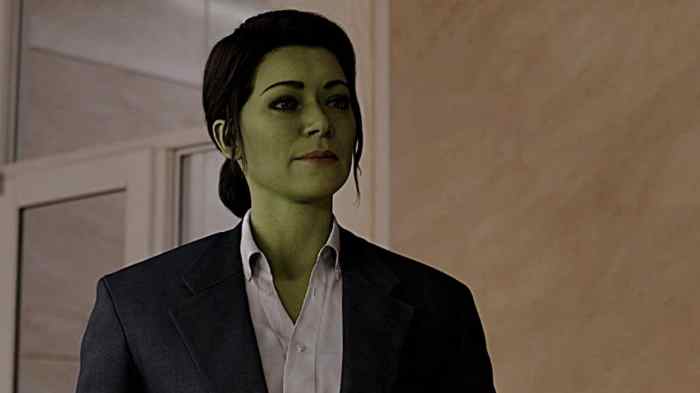She-Hulk: Attorney at Law’s portrayal of the People vs. Emil Blonsky offers a fascinating exploration of legal complexities within a superhuman context. This case, far from a simple courtroom drama, delves into themes of redemption, second chances, and the inherent challenges of applying traditional justice to individuals with extraordinary abilities. The episode masterfully weaves together legal arguments, character development, and visual storytelling to create a compelling narrative that resonates far beyond the confines of the courtroom.
We will examine Emil Blonsky’s transformation from villain to a participant in a support group, analyzing his journey from his initial portrayal in “The Incredible Hulk” to his nuanced character arc in the She-Hulk series. We will also scrutinize the legal intricacies of his case, Jennifer Walters’ ethical dilemmas, and the broader implications for superhuman rights within the context of a seemingly ordinary legal system. The visual elements and narrative style used to present this storyline will be explored, highlighting how the show’s creators effectively use these tools to convey emotion and underscore the central themes.
Themes of Justice and Accountability

She-Hulk: Attorney at Law, in the episode focusing on Emil Blonsky, presents a nuanced exploration of justice and accountability, moving beyond simplistic notions of punishment and retribution. The episode challenges viewers to consider the complexities of rehabilitation, societal responsibility, and the ethical implications of possessing extraordinary abilities, particularly within the framework of a legal system designed for ordinary citizens.
Blonsky’s case highlights the inherent tension between the desire for retribution and the potential for rehabilitation. The episode showcases differing perspectives on justice, contrasting the public’s demand for punishment for Blonsky’s past actions with his genuine efforts at self-improvement and rehabilitation. This conflict underscores the limitations of a justice system primarily focused on punishment rather than restorative justice.
Rehabilitation versus Punishment in Blonsky’s Case
The episode directly confronts the dichotomy between punishing Blonsky for his past crimes and acknowledging his significant progress in self-control and rehabilitation. While the public, fueled by fear and past trauma, largely favors punishment, the legal system, through Jennifer Walters’ representation, grapples with the ethical implications of incarcerating a reformed individual. The episode suggests that a solely punitive approach might be counterproductive, potentially hindering the very rehabilitation it aims to achieve. Blonsky’s participation in a self-help group and his demonstrable efforts to control his transformations are presented as evidence of his commitment to change, prompting reflection on the role of restorative justice in achieving a more equitable outcome. The episode doesn’t offer easy answers but rather presents the complexities of balancing justice with the possibility of redemption.
Legal Responses to Superpowered Individuals
The episode implicitly compares and contrasts the legal system’s response to Blonsky with its treatment of other superpowered individuals. While Blonsky’s case is presented with a degree of nuance and understanding, the show subtly hints at a more punitive and less forgiving approach towards other individuals with extraordinary abilities. This disparity suggests a systemic bias in how the legal system addresses those with superhuman powers, often prioritizing containment and control over rehabilitation and restorative justice. The lack of clear legal frameworks specifically designed for individuals with superhuman abilities further complicates the issue, highlighting the need for a more comprehensive and equitable approach.
Societal Responsibility and the Ethics of Superhuman Abilities
She-Hulk explores the broader themes of societal responsibility and the ethical implications of superhuman abilities. Blonsky’s case serves as a microcosm of the larger societal anxieties surrounding individuals with extraordinary powers. The episode raises questions about how society should respond to the potential dangers and benefits of such abilities, suggesting that a balanced approach is necessary, one that acknowledges both the potential threats and the possibility of rehabilitation and positive contributions. The episode implicitly argues for a more nuanced and empathetic understanding of individuals with superhuman abilities, moving beyond simple fear and prejudice towards a more thoughtful and responsible approach. The fear and distrust exhibited by the public towards Blonsky, even after his demonstrated efforts at self-improvement, underscore the complex ethical challenges of integrating individuals with exceptional abilities into mainstream society.
Final Conclusion

Ultimately, “The People vs. Emil Blonsky” in She-Hulk: Attorney at Law serves as a powerful commentary on justice, accountability, and the ongoing struggle to define both within a world increasingly populated by individuals with extraordinary powers. Blonsky’s journey, though fictional, prompts reflection on the very nature of rehabilitation, the limits of punishment, and the complexities of societal responsibility in an era where the boundaries of human potential are constantly being redefined. The episode’s success lies not just in its engaging narrative but in its thought-provoking exploration of these critical themes, leaving viewers with lingering questions about the true meaning of justice and the possibility of redemption.
Popular Questions
What is Emil Blonsky’s support group like?
Blonsky’s support group consists of other superpowered individuals, providing a unique setting for rehabilitation. It emphasizes accountability and self-reflection, differing from traditional methods focused solely on punishment.
What are the key ethical dilemmas Jennifer Walters faces?
Walters grapples with representing a known villain, balancing her professional obligations with her personal feelings and the potential implications of her actions on the wider community.
How does the episode’s visual style contribute to the narrative?
The show utilizes color, lighting, and camera angles to emphasize emotional moments, highlighting the contrast between the formal courtroom setting and the emotional turmoil of the characters involved.